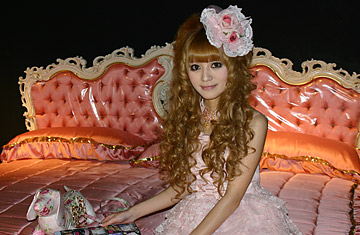
Keiko Mizoe, 24, works at Jesus Diamante's Shinjuku store. The fashion brand requires its sales clerks to model its wares
The three girls walking down Meiji Street in the heart of Tokyo's Harajuku district are talking loudly in cute high voices, sometimes breaking into giggles. They could be any group of teenage girls on a merry shopping expedition in the Japanese capital's mecca of youth fashion — except for the fact that they are clad in clothing and accessories that mimic the look of comic-book heroines wearing the style of 18th-century princesses.
"My father asked me, 'Where on earth are you going in that?' " says Mayuka Watanabe, laughing. She is a 17-year-old high school student sporting a headband with a big ribbon and three pink roses. Her friend Miki Takahashi, 18, who takes her fashion inspiration from Cinderella, adds, "People look at me and sometimes even point a finger at me. Once a little kid on the train looked at me and exclaimed, 'Look, there is a fairy!' which was kind of embarrassing, but I didn't care because I just wear what I like." Sanae Nagamine, a 21-year-old waitress from Hitachi in northeastern Ibaraki prefecture, had to take a two-hour train ride to join her friends on this pilgrimage to Jesus Diamante, one of the first fashion brands to promote hime-kei, as the look is known, with its frilly pastel frocks and ringlet hairdos. With money earned from part-time work, the girls plan to shop for two hours at the brand's Harajuku store before heading to its Shinjuku branch. "I love their design. It amps me up!" enthuses Nagamine. (Watch TIME's video "Princess Fashion in Tokyo.")
Hime-kei appears to have been inspired by American filmmaker Sofia Coppola's movie Marie Antoinette, with its lush rendering of the decadence of the court of Louis XVI. The rush of young Japanese women to emulate the look of 18th-century French aristocrats has grown from a fad into something of a movement, whose leader is the popular singer Ayumi Hamasaki. It even has its own magazine, Koakuma Ageha, with a circulation of 350,000. If Coppola's movie created the wave, Osaka-based Jesus Diamante was ready to ride it. Established in 2001, the label had offered luxurious clothing styled for a hypothetical heiress with a likeness to French actress Brigitte Bardot. But the impact of Marie Antoinette prompted it to introduce such lines as Marie Wanpi, with a ball gown sporting a large ribbon on the chest and a Cinderella coat with a fur collar and sleeve edges.
Takatoshi Imada of Tokyo's Institute of Technology, Value and Decision Science sees hime-kei as a response to an unsatisfying way of life. "The hime-kei girls removed the borders between the virtual and real worlds," says Imada, who believes the phenomenon is rooted in a rejection of the goals of advancement through hard work in an ailing market economy. "They longed for a different form of self-expression and sought a more meaningful way of life." Searching for meaning through the fashions of a doomed European aristocracy may be a form of protest against a business-driven contemporary Japanese culture, but it's certainly made healthy profits for the Jesus Diamante label. Today, the company runs four stores; by mid-2007 it had earned more than $14 million from selling dresses that run from $500 to $600 each and coats that cost up to $1,500. The average client spends $1,000 a month in support of her princess habit — but some spend as much as $4,000 a month. Most clients are girls in their teens to mid-20s, but there are some women in their 30s and 40s who wear the look. (See pictures of Japanese design's greatest hits.)
Customer loyalty comes easily in a fashion movement that can seem to border on a cult. The company requires its sales clerks to model its wares, both in stores and on its website, and that has resulted in some of its retail staff developing their own fan bases. Most popular among them is Keiko Mizoe, 24, a staffer in the Shinjuku store with the flawless complexion of a porcelain doll. "When people started to call me Princess Keiko, I didn't like it and didn't know what to do," Mizoe confesses. "But then I started to think that if others see me in that way, then I have to act my part." These days she regularly models for Koakuma Ageha and sometimes even appears on TV. "Every day I enjoy very much being a girl. I am just an ordinary girl who happens to be a princess. The world is my oyster. I am the luckiest girl alive," says Mizoe, who is wearing a pink frilly dress with a big flower accessory in her perfectly curled hair. "I always want to enjoy the princess fashion and wear pink no matter how old I get."
"Every little girl loves princesses. And any girl at least once pretended to be one and liked pink and frills," says Yuri Chinomi, a designer and managing director for Jesus Diamante. "I was so happy when I got a dress with frills bought for me, although I could wear it only on special occasions. There are definitely adults who still remember that kind of excitement. I want them to feel it again wearing our fashion."
Adds Takako Hosomi, president of Princess House Inc., whose clients demand that their living spaces be transformed to mimic 18th-century European palaces: "It's every girl's dream to wake up on a splendid canopy bed with a kiss from a handsome prince."
In Japan's depressed economy, "princes" who can offer their brides an aristocratic lifestyle are an endangered species. But like the entourage of Marie Antoinette, the hime-kei girls keep on spending as if they live in their very own bubble economy.
